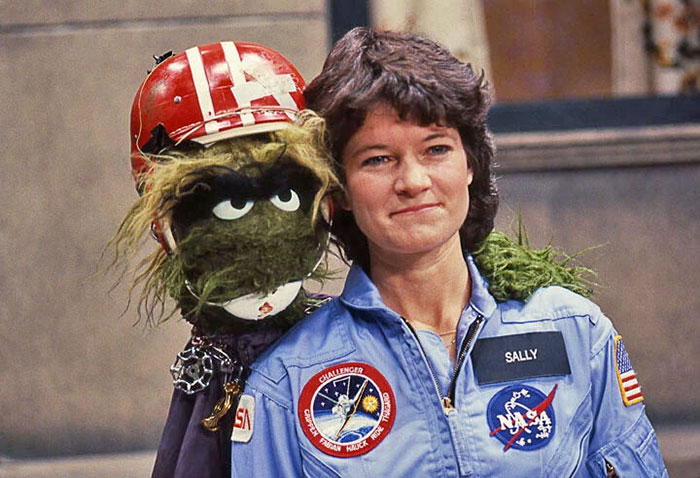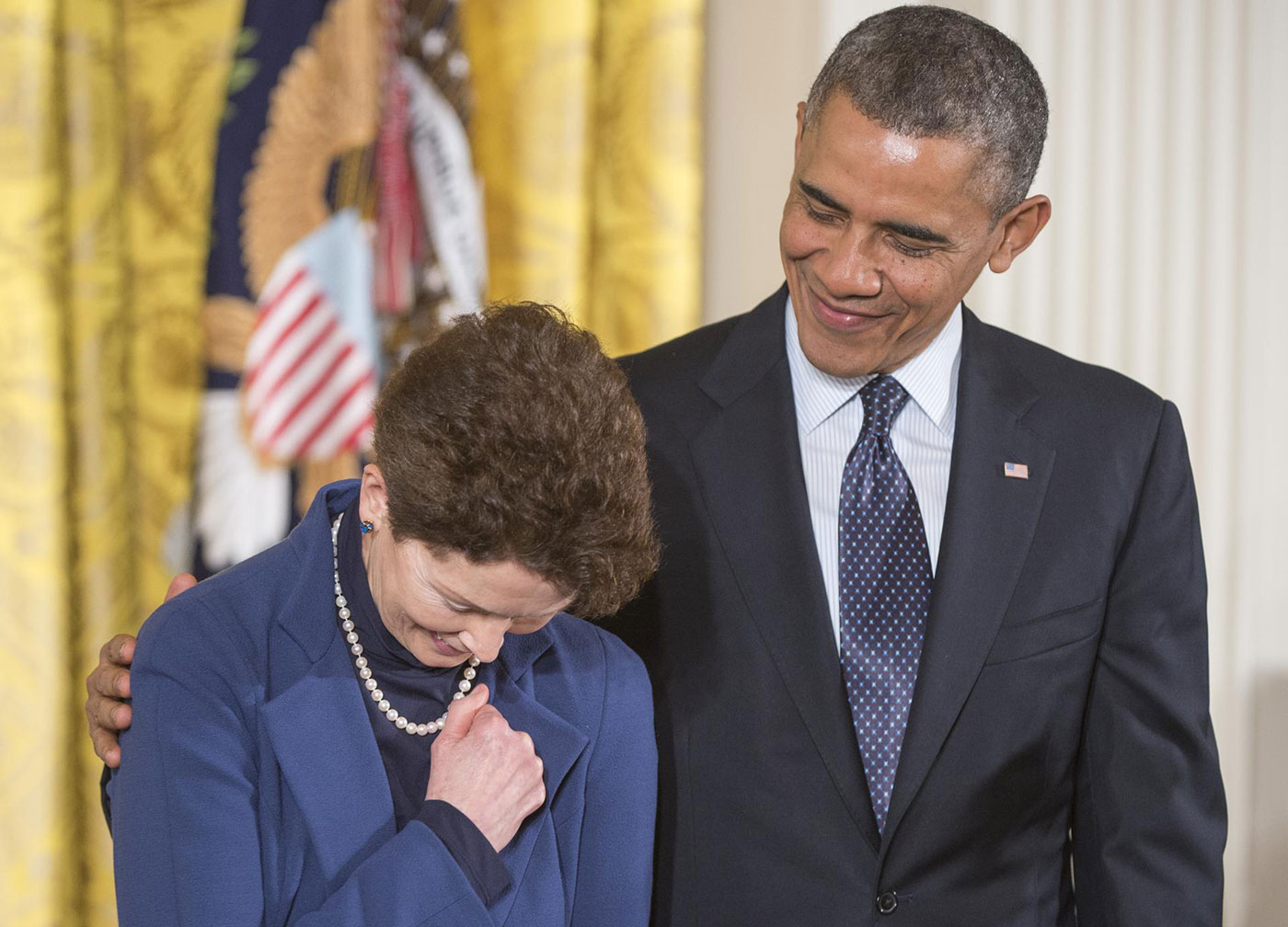By:
- Margaret King
Published Date
By:
- Margaret King
Share This:
20 Things You Might Not Know About Sally Ride
Sally Ride is remembered as the first American woman in space and as a champion of diversity and equity in science education. But those were only two aspects of a rich and multi-faceted life. To mark the 20th anniversary of the founding of Sally Ride Science, here are 20 things you might not know about Sally Ride:
- She aspired to play shortstop for the Dodgers.
Growing up in Los Angeles, Sally was a huge Dodgers fan. Her father, Dale, often challenged her to calculate baseball stats. Sally even dreamed of becoming the Dodgers’ shortstop, but her mother, Joyce, told her that was one job she, as a girl, could not aspire to. Joyce suggested she try tennis instead. - Her parents didn’t understand her interest in science.
Sally’s mom and dad were puzzled by her fascination with science, but they strongly encouraged her. They gave her a chemistry set and a telescope and got her a subscription to ‘Scientific American.’ - She was an avid stamp collector.
Sally started collecting Olympic stamps during a European trip with her family when she was 9. In her teens, she focused on stamps honoring space explorers. She continued adding to her collection for the rest of her life. Sally would have been delighted to know that she would one day appear on a Forever stamp issued by the U.S. Postal Service. - She and her future life partner were girlhood pals.
Sally first met Tam O’Shaughnessy when they were preteens playing on the junior tennis circuit in Southern California. Tam noticed Sally because she walked on her toes like a ballet dancer. They became good friends and eventually life partners who spent 27 years together before Sally’s death from pancreatic cancer in 2012. - She played tennis against Billie Jean King.

Billie Jean King played Sally, then an undergraduate at Stanford, in a tennis mixed doubles exhibition in 1972. The male players were Dick Peters and Dennis Van der Meer. Photo courtesy of Molly Tyson.
While attending Stanford, Sally taught tennis at a summer camp in Lake Tahoe. When tennis champion Billie Jean King visited the camp in 1972, she played an exhibition doubles match against Sally. King told Sally that if she worked hard, she could become a pro player. But Sally had already decided on a physics career. Later, when asked why she decided not to try for a tennis career, she would answer jokingly, “My forehand.” She also said, “I realized…that my education, science, was more important to me than tennis was.” - She decided over scrambled eggs that she wanted to be an astronaut.
In 1977, Sally was finishing her Ph.D. in physics at Stanford and planning to become a university professor. One morning, she was eating breakfast in the cafeteria and reading the student newspaper when she noticed an article saying NASA was looking for new astronauts, and for the first time, women could apply. Sally realized in that instant that she wanted to fly in space. She immediately dashed off a letter to NASA asking for an application for the astronaut corps. - Her sister is a minister.

Sally and her younger sister, Bear, chose contrasting career paths.
In 1978, the same year Sally became an astronaut, her younger sister, Bear, was ordained as a Presbyterian minister. Their mom, Joyce, joked, “We’ll see who gets to heaven first.” - She was the voice of ground control.
Before she flew in space, Sally was the first female CAPCOM (capsule communicator), the voice talking to astronauts on the space shuttle. She guided astronauts on mission STS-2 (1981) and STS-3 (1982) with precision and good humor. Soon afterward, she became the first woman assigned to a shuttle crew. - She was a daredevil.

Three days before her first spaceflight, Sally gets ready to take off from Houston in a T-38 jet to fly to NASA's Kennedy Space Center in Florida. NASA photo.
Sally loved the part of her astronaut training that required flying in sleek T-38 jets, sometimes upside down, at 500 mph. She also practiced ejecting and using a parachute. She usually sat in the copilot seat behind astronaut John Fabian, a former Air Force pilot. She liked riding in the T-38 so much that she took flying lessons and earned her pilot’s license. - She had to set NASA engineers straight about some things.
When Sally was preparing for her first spaceflight, mission STS-7 aboard shuttle Challenger in 1983, NASA engineers were clueless about what special supplies a woman astronaut might need. “I remember the engineers trying to decide how many tampons should fly on a one-week flight,” Sally said later. “They asked, ‘Is 100 the right number?’” She replied, “No, that would not be the right number.” - She put up with some dumb questions.
In the runup to her historic flight, Sally was the focus of a media frenzy. Reporters peppered her with silly, sexist questions, but she managed to respond with humor and grace. During one news conference, she was asked, “Do you weep when things go wrong on the job?” Sally laughed and gestured to her crewmate Rick Hauck, replying, “Why don’t people ask Rick those questions?” - She had a secret meeting with a Russian cosmonaut
A few months after Sally returned from space, NASA sent her on a three-week tour of Europe. Cold War tensions were high, so she was instructed not to mingle with Russian cosmonauts. But in Hungary, she ran into Svetlana Savitskaya, a Russian who had flown in space the year before Sally did. The two women arranged a secret meeting and spent hours swapping stories about spaceflight. - She costarred with the Muppets.

In one of her Sesame Street segments, Sally appears with Grundgetta, girlfriend of Oscar the Grouch.
After Sally’s first spaceflight, she taped three Sesame Street segments in January 1984. Sally, a very private person, was uncomfortable with the intense publicity surrounding her. But she warmed to making appearances where she had a chance to inspire young people. - Her second mission marked two more “firsts” for women.

Sally, right, and Kathryn Sullivan synchronize watches before entering shuttle Challenger to launch on mission STS-41G, Sally’s second spaceflight. NASA photo.
Sally’s second shuttle flight made history as the first space mission with two female crew members. When Challenger blasted off for STS-41G on Oct. 5, 1984, Sally was joined by Kathryn Sullivan. During the mission, Sullivan became the first American woman to walk in space. For Sally, having another woman on the crew made things easier. She said of Sullivan, “At least she had someone to share the attention with." - She had a sly sense of humor
On the first day of mission STS-41G, Mission Control woke up the astronauts by saying "Good morning, Challenger." Instead of saying "Roger," Sally pretended to be an answering machine: "We're sorry, nobody can take your call right now. Please leave your name and number..." The other astronauts kept up the joke throughout the mission. - She helped investigate both of the nation’s space shuttle tragedies.
Sally had flown twice aboard Challenger and was training for a third mission on the shuttle. Then, on Jan. 28, 1986, Challenger exploded shortly after liftoff, killing all seven crew members. As a member of the presidential commission investigating the disaster, Sally helped bring to light the fact that NASA management knew the shuttle’s O-rings could fail in cold temperatures. Then, when shuttle Columbia broke up on reentry in 2003, Sally again was named to the investigative panel, becoming the only person to serve on the commissions investigating both space shuttle tragedies. - She was a Trekkie
Growing up, Sally was a big fan of the Star Trek TV series, and in 1995, she attended a premiere screening of the Star Trek: Voyager series. Actress Kate Mulgrew, aka Captain Janeway, gave Sally a Star Trek crew pin. Today, you can see that pin in the Smithsonian National Air and Space Museum, home of the Sally K. Ride Collection of papers and personal artifacts. - She co-wrote science books for children.
Inspired by the writings of Isaac Asimov, Sally and Tam worked together to write a number of science books for young readers. Their book “The Third Planet: Exploring the Earth from Space” won the prestigious Children’s Science Writing Award from the American Institute of Physics in 1995. - She inspired female astronauts who came after her.

Two months after Sally’s death, astronaut Sandra Magnus places a rose at a tree planted in Sally’s memory in Astronaut Memorial Grove at NASA’s Johnson Space Center. NASA photo.
After Sally’s death in 2012, a group of female astronauts gathered for the dedication of a tree in her memory in Astronaut Memorial Grove at NASA’s Johnson Space Center. Ellen Ochoa, the first Hispanic woman in space, later described the scene. “As we went around the table, just about every single woman in the astronaut office, current and former, had been personally affected by Sally,” Ochoa said. “As much in demand as she was, she always made time to meet with young women who dreamed of becoming astronauts.” - After her death, she received the nation’s highest civilian honor.

President Obama shares an emotional moment with Tam O’Shaughnessy while presenting her with Ride’s posthumous Medal of Freedom in 2013. NASA photo/Carla Cioffi.
In 2013, President Obama honored Sally posthumously with the Presidential Medal of Freedom, which he presented to Tam. "As the first American woman in space, Sally did not just break the stratospheric glass ceiling, she blasted through it," Obama said. "And when she came back to Earth, she devoted her life to helping girls excel in fields like math, science and engineering."
Share This:
You May Also Like
UC San Diego is Strengthening U.S. Semiconductor Innovation and Workforce Development
Technology & EngineeringStay in the Know
Keep up with all the latest from UC San Diego. Subscribe to the newsletter today.



